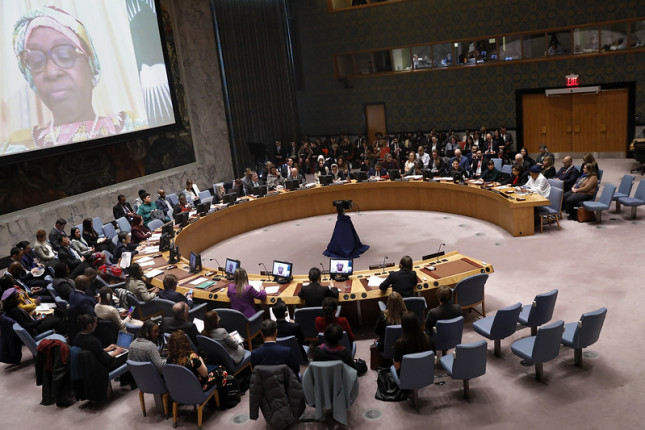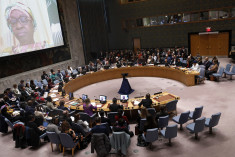-
Connecting the Dots: Women, Peace, and Security and Reproductive Health
September 20, 2023 By Bridget Kelly
It is well established that women’s and girls’ lives are disproportionately affected by humanitarian emergencies—and that these crises often underscore pre-existing discriminatory practices. According to the United Nations Population Fund (UNFPA), women and children account for more than 75 percent of those at risk from war, famine, persecution, and natural disaster. During these emergencies (and in their aftermath), women and girls are exposed to greater threats, such as the loss of livelihoods, education, and security due to displacement and the breakdown of social order.

It is well established that women’s and girls’ lives are disproportionately affected by humanitarian emergencies—and that these crises often underscore pre-existing discriminatory practices. According to the United Nations Population Fund (UNFPA), women and children account for more than 75 percent of those at risk from war, famine, persecution, and natural disaster. During these emergencies (and in their aftermath), women and girls are exposed to greater threats, such as the loss of livelihoods, education, and security due to displacement and the breakdown of social order.
Humanitarian emergencies also often result in higher levels of gender-based violence (GBV) targeted against women and girls, including killings, torture, sexual violence, and forced and/or early marriage. It has been estimated that more than 70 percent of women and girls in some crisis settings have experienced different forms of GBV. Approximately one in five refugee or displaced women in complex humanitarian settings experience sexual violence. Surges in GBV are also common in times of post-crisis.
From Afghanistan to Ethiopia, from Syria to Sudan, the human rights of women and girls are deliberately targeted during times of unrest. As armed conflict and environmental crises restrict women’s and girls’ access to basic educational and health resources and worsen ongoing risks of gender-based and sexual violence, holistic approaches to women, peace, and security (WPS) efforts should be explored.
Women and Humanitarian Emergencies
Conflict and environmental emergencies cause disruptions in daily life, including in education and in the delivery of essential health services. These discontinuities create a disproportionate impact on women and girls. Adolescent girls in conflict zones are 90 percent more likely to be out of school compared to girls in conflict-free countries. They also face increased care-related tasks on the home front, such as providing food and water. The capacity of healthcare systems is often weakened during times of crises due to disruptions in supply chains, the lack of electricity or water supply, and fewer healthcare workers. All of these factors combine and culminate in a lack of access to health services.
Yet women’s and girls’ need for healthcare, especially sexual and reproductive health (SRH) services, does not cease suddenly during an emergency. On the contrary, the need for such services becomes greater as humanitarian emergencies wreak devastating consequences on sexual and reproductive health and rights (SRHR). Insufficient or inaccessible access to contraception and family planning services, maternal and newborn health services, safe abortion services, as well as the prevention of GBV and of HIV and sexually transmitted infections (STIs) can have a wide range of negative effects. Crises can result in women and girls being at a greater risk of unplanned pregnancy, maternal mortality and morbidity, and STIs.
While women and girls often experience an unequal share of the burdens in a humanitarian emergency, they are rarely included at the decision-making tables where peace and security efforts are negotiated. The U.N. Security Council Resolution (UNSCR) 1325, adopted in 2000, recognizes the critical role of women in peace negotiations, peacebuilding, peacekeeping, humanitarian response, and in post-conflict reconstruction. The WPS agenda evolved from UNSCR 1325, and its four pillars—participation, protection, prevention, and relief and recovery—further reinforce the notion that women have the human right to participate in decision-making processes that affect them.
Women’s meaningful contribution to issues of peace and security is not only recognized by international human rights instruments, but it has another vastly positive aspect: including women often results in more peaceful solutions. Research shows that when women fully and meaningfully participate in the peace process, the duration of a peace agreement is more likely to last longer.
As Hala Al-Karib, Regional Director of the Strategic Initiative for Women in the Horn of Africa, stated when addressing the U.N. Security Council, “the modern history of Sudan is littered with peace agreements that have failed because they excluded women. We must learn from our past mistakes, or else risk making them again.”
A Critical Link
Developing multisectoral approaches to support women’s participation in peace processes can help create enabling environments for their engagement. And it is clear that SRHR issues must be included in peace processes not only to support those whose rights have been violated during times of crises, but also to build a strong recovery. It is in such moments of turmoil that investments in SRHR should be prioritized, because advancing SRHR can be a critical step to making space for women at the decision-making table. Without access to comprehensive SRH services, women’s ability to participate in peace processes is undermined—and threatens the realization of lasting peace.
The link between SRHR issues is clear. How can women be expected to fully participate when they are deprived of access to contraception that is needed to avoid an unwanted pregnancy? Disruptions to health systems in Afghanistan are expected to lead to roughly 4.8 million unintended pregnancies by 2025, an outcome that UNFPA observes could jeopardize the country’s stability, peace, and recovery.
Can women be expected to meaningfully participate when they are unable to access safe, timely, respectful, and culturally appropriate maternity care, and thus put their lives as risk? More than 500 women and girls die in emergency situations every day from complications due to pregnancy and childbirth.
And how can women fully and meaningfully participate when peacekeeping experts suggest that armed conflict means it is more dangerous to be a woman than a soldier on the battlefield? Women and girls are primarily and increasingly targeted by the use of sexual violence as a tactic of war, with a majority of survivors not reporting their abuse due to a lack of trust in the system.
The heightened risk for women and girls during times of upheaval carries with it a more pressing need for ensuring access to SRH services. Funding for SRHR continues to be a critical component often overlooked in matters of peace and security. However, greater investments in SRHR can enable women’s full and meaningful participation in paths to peace—as it also accelerates progress toward ensuring the health and wellbeing of their communities. Recognizing this connection will advance efforts to ensure women’s participation in the processes that can bring progress towards a more peaceful society.
Bridget Kelly is the Director of Research for Sexual and Reproductive Health and Rights at the Population Institute.
Sources: Action Aid; AP; International Rescue Committee; New York Times; OHCHR; Population Institute; Reproductive Health Journal; SSRN; Tidsskriftet; UN; UNESCO; UNFPA; USIP; WHO.
Photo Credit: UN Women Executive Director Sima Bahous addresses the Security Council Open Debate: “Women, Peace and Security: Towards the 25th Anniversary of 1325.” Photo: UN Women/Ryan Brown.
 A Publication of the Stimson Center.
A Publication of the Stimson Center.




